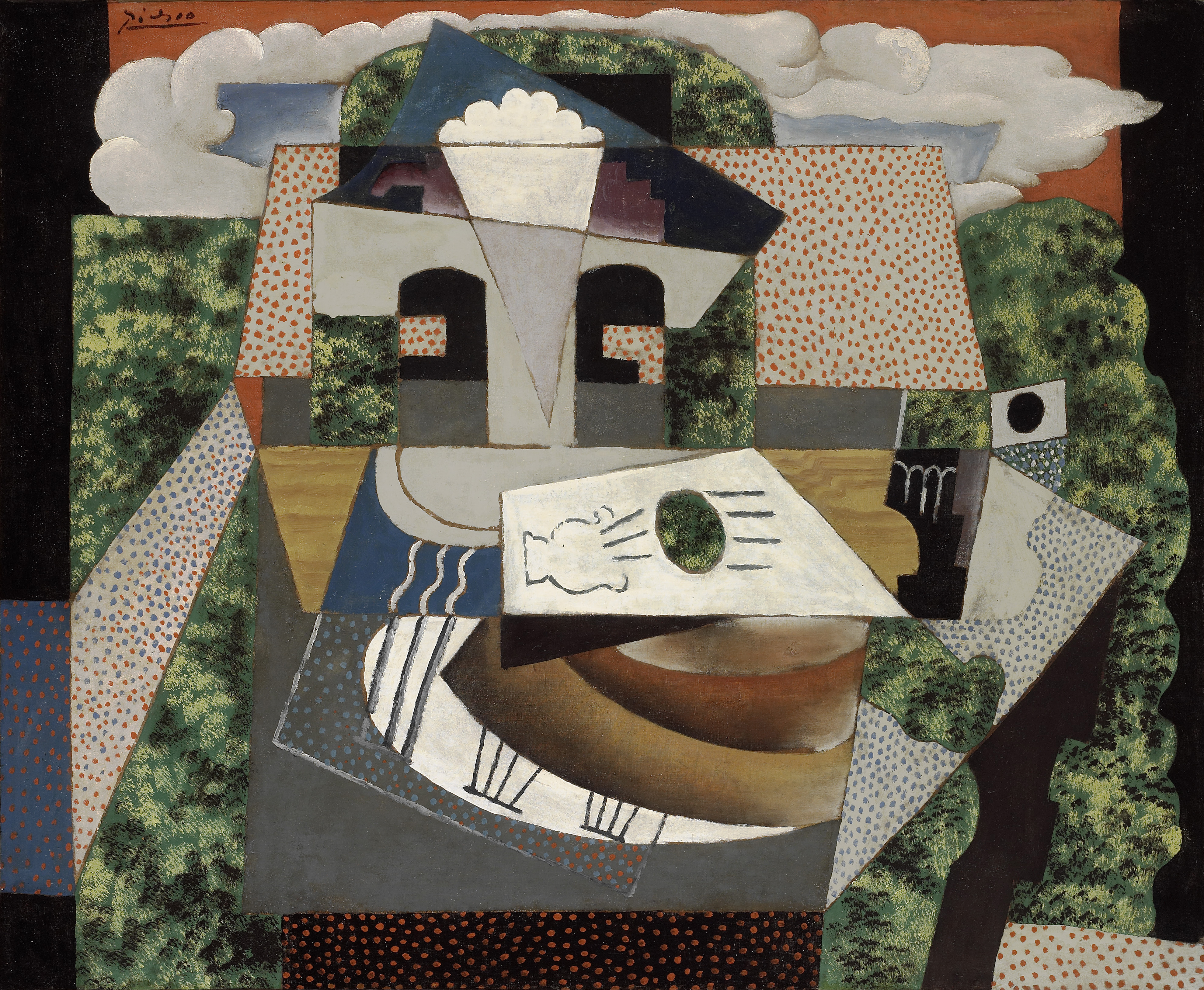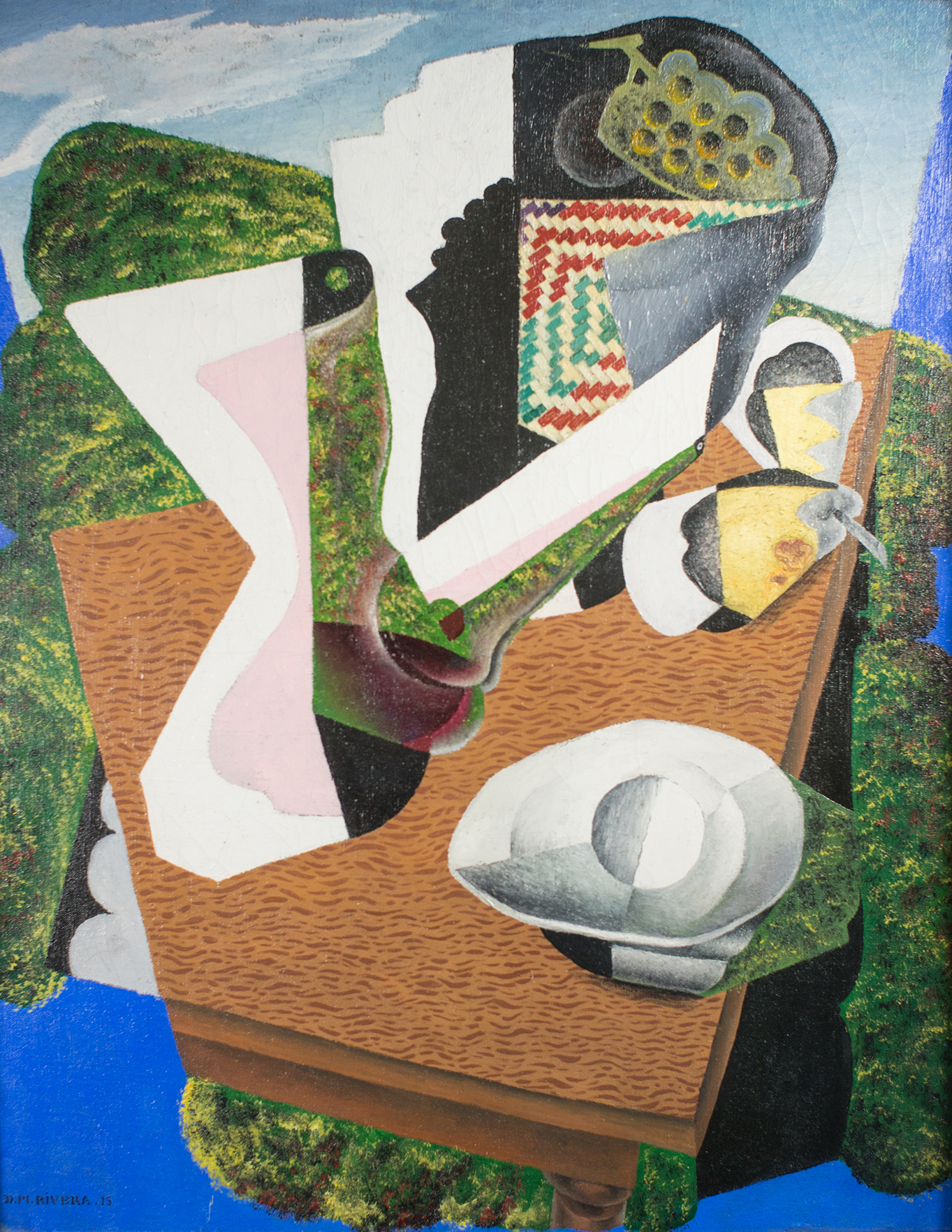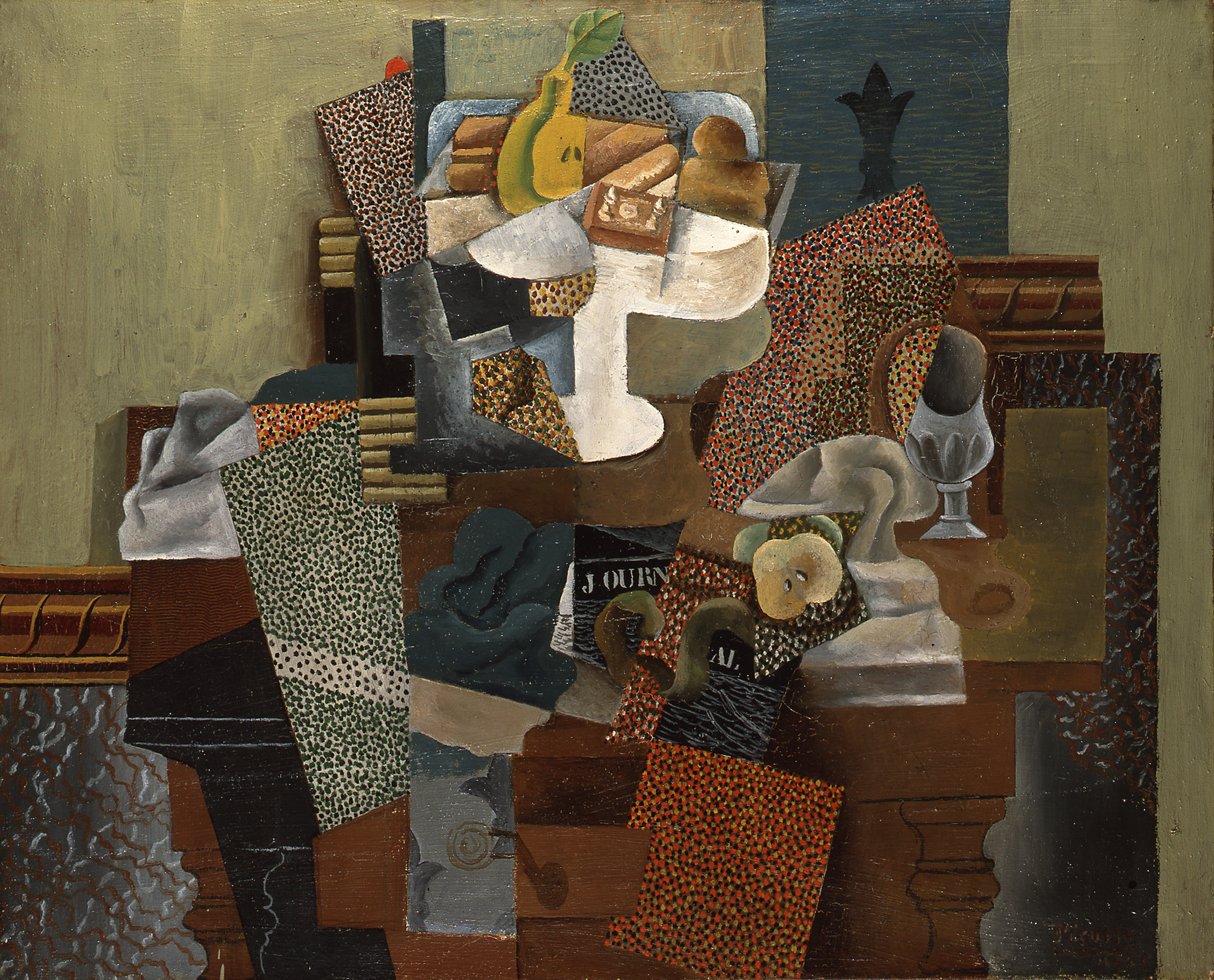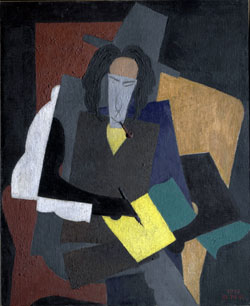Meadows Museum, Dallas
Nicole Atzbach, “Picasso/Rivera: Still Life and the Precedence of Form,” At the Meadows, Spring 2017, pp. 9–12:
During the run of his first solo exhibition at the Paris gallery of Berthe Weill in spring 1914, Mexican artist Diego Rivera (1886-1957) had an opportunity to visit Pablo Picasso (1881-1973) in his Paris studio. Rivera recounts this solemn rite of passage:
–from D. Rivera, My Art, My Life
By late summer of 1915, much had changed within the Parisian artistic landscape from just the year before. Many artists had deserted the city, having been conscripted to serve in the First World War. Those who remained, such as Juan Gris and María Blanchard, were finding their own way with Cubism, while Rivera now had a bone to pick with Picasso, whom he previously professed to revere.
The source of Rivera’s ire was the perceived semblance between his 1915 Zapatista Landscape (The Guerrilla) and Picasso’s Seated Man (1915-16), which in its first iteration–as seen by Rivera in another visit to Picasso’s studio in August 1915–was known as Man Seated in Shrubbery. Rivera noted acute similarities between his canvas and that of the early state of Picasso’s work; namely, both works featured a similarly structured still life set outdoors. The Mexican artist’s very specific complaint was his former mentor’s liberal borrowing of Rivera’s formulaic foliage–scumbled patches of green and white paint on a dark ground.
The rumblings of Picasso’s plagiarism stirred some paranoia in the artistic coterie of Montparnasse, causing some to close their studio doors to the Spanish artist and to each other. Some of this concern was more mock than genuine; Jean Cocteau, poet, designer, and recent friend of Picasso, recalled “one week when everybody was whispering and wondering who had stolen Rivera’s formula for painting trees by scumbling green on black.”
Rivera’s widely broadcast complaint may have incited Picasso’s significant alteration of Seated Man (he painted out much of the disputed greenery), though in Rivera’s eyes this perceived plagiarism was the ultimate affront fol- lowing a number of instances that the Spaniard had riffed on Rivera. Picasso/Rivera: Still Life and the Precedence of Form takes as its point of departure another case study of the two artists’ works: Picasso’s Still Life in a Landscape (1915) at the Meadows, which will be displayed for the first time with Rivera’s Still Life with Gray Bowl (Lyndon Baines Johnson Presidential Library, Austin), painted in the same year. Exhibited in close proximity, these two paintings together encapsulate the two artists’ storied overlapping of themes and motif appropriation during that period.
Echoing key elements of Rivera’s canvas, Picasso’s still life features the familiar foliage devised by Rivera as well as a slice of sky above. The compositional similarities of these two works seem to extend beyond mere artistic rivalry, pointing to a common theme that both Picasso and Rivera were actively exploring in 1915: a still life set outdoors. Perhaps during their discussion at their initial meeting in 1914 about the future of Cubism, Picasso and/or Rivera thought to take the “‘new’ art form” to the past–to the Renaissance idea of painting as a window on the world.
AUGUST 6-NOVEMBER 5, 2017
Nicole Atzbach, “Picasso/Rivera: Still Life and the Precedence of Form,” At the Meadows, Spring 2017, pp. 9–12:
During the run of his first solo exhibition at the Paris gallery of Berthe Weill in spring 1914, Mexican artist Diego Rivera (1886-1957) had an opportunity to visit Pablo Picasso (1881-1973) in his Paris studio. Rivera recounts this solemn rite of passage:
I went to Picasso’s studio intensely keyed up to meet Our Lord, Jesus Christ.... As for the man...
a luminous atmosphere seemed to surround him.... Picasso asked me to stay and have lunch with him, after which he went back with me to my studio. There he asked to see everything I had done from beginning to end....[W]e had dinner together and stayed up practically the whole night talking. Our thesis was Cubism–what it was trying to accomplish, what it had already done, and what future it had as a “new” art form.
–from D. Rivera, My Art, My Life
By late summer of 1915, much had changed within the Parisian artistic landscape from just the year before. Many artists had deserted the city, having been conscripted to serve in the First World War. Those who remained, such as Juan Gris and María Blanchard, were finding their own way with Cubism, while Rivera now had a bone to pick with Picasso, whom he previously professed to revere.
The source of Rivera’s ire was the perceived semblance between his 1915 Zapatista Landscape (The Guerrilla) and Picasso’s Seated Man (1915-16), which in its first iteration–as seen by Rivera in another visit to Picasso’s studio in August 1915–was known as Man Seated in Shrubbery. Rivera noted acute similarities between his canvas and that of the early state of Picasso’s work; namely, both works featured a similarly structured still life set outdoors. The Mexican artist’s very specific complaint was his former mentor’s liberal borrowing of Rivera’s formulaic foliage–scumbled patches of green and white paint on a dark ground.
The rumblings of Picasso’s plagiarism stirred some paranoia in the artistic coterie of Montparnasse, causing some to close their studio doors to the Spanish artist and to each other. Some of this concern was more mock than genuine; Jean Cocteau, poet, designer, and recent friend of Picasso, recalled “one week when everybody was whispering and wondering who had stolen Rivera’s formula for painting trees by scumbling green on black.”
Rivera’s widely broadcast complaint may have incited Picasso’s significant alteration of Seated Man (he painted out much of the disputed greenery), though in Rivera’s eyes this perceived plagiarism was the ultimate affront fol- lowing a number of instances that the Spaniard had riffed on Rivera. Picasso/Rivera: Still Life and the Precedence of Form takes as its point of departure another case study of the two artists’ works: Picasso’s Still Life in a Landscape (1915) at the Meadows, which will be displayed for the first time with Rivera’s Still Life with Gray Bowl (Lyndon Baines Johnson Presidential Library, Austin), painted in the same year. Exhibited in close proximity, these two paintings together encapsulate the two artists’ storied overlapping of themes and motif appropriation during that period.
Echoing key elements of Rivera’s canvas, Picasso’s still life features the familiar foliage devised by Rivera as well as a slice of sky above. The compositional similarities of these two works seem to extend beyond mere artistic rivalry, pointing to a common theme that both Picasso and Rivera were actively exploring in 1915: a still life set outdoors. Perhaps during their discussion at their initial meeting in 1914 about the future of Cubism, Picasso and/or Rivera thought to take the “‘new’ art form” to the past–to the Renaissance idea of painting as a window on the world.
10 upcoming exhibitions
With Still Life in a Landscape, Picasso seems to be following the lead of Henri Matisse’s iconic Open Window, Collioure (1905). Picasso playfully posits a thoroughly Cubist composition–marked by multiple points of perspective and the fracturing of objects in rejection of traditional pictorial conventions–within a metaphorical frame conceived by fifteenth-century theorist Leon Battista Alberti that, prior to the age of Cubism (or
more precisely, Paul Cézanne), would have presented a composition marked by linear perspective and mimetic representation. The juxtaposition of such diametrically opposed ideas fits perfectly within the game playing of synthetic Cubism: the integration of patterned and other- wise decorated, collage-like components (such as Rivera’s trees, which Picasso clearly did not consider proprietary) in Still Life in a Landscape underscores the two-dimen- sionality and shallow pictorial space of the composition framed by a sky and trees–vestiges of a simulated world. As a postscript, Picasso left the canvas exposed in select areas not only to create borders between elements but also to emphasize the artifice of the painting.
Rivera’s work from the Lyndon Baines Johnson Presidential Library includes similar visual cues: objects placed on a table bordered by the token foliage and set beneath–or within–a blue sky. A comparison of these two 1915 Cubist works by two different artists sheds light on their distinct vernaculars, such as their individual treatment of the compote, an essential component of the still life. The close parallels of these two canvases fuel the stories of spirited rivalry between Picasso and Rivera. It should be remembered, however, that in wartime Paris other expatriate artists were also exploring possibilities of the open window, including Gris, who preceded both Picasso and Rivera with his own rendering of a still life before an open window in June 1915.
more precisely, Paul Cézanne), would have presented a composition marked by linear perspective and mimetic representation. The juxtaposition of such diametrically opposed ideas fits perfectly within the game playing of synthetic Cubism: the integration of patterned and other- wise decorated, collage-like components (such as Rivera’s trees, which Picasso clearly did not consider proprietary) in Still Life in a Landscape underscores the two-dimen- sionality and shallow pictorial space of the composition framed by a sky and trees–vestiges of a simulated world. As a postscript, Picasso left the canvas exposed in select areas not only to create borders between elements but also to emphasize the artifice of the painting.
Rivera’s work from the Lyndon Baines Johnson Presidential Library includes similar visual cues: objects placed on a table bordered by the token foliage and set beneath–or within–a blue sky. A comparison of these two 1915 Cubist works by two different artists sheds light on their distinct vernaculars, such as their individual treatment of the compote, an essential component of the still life. The close parallels of these two canvases fuel the stories of spirited rivalry between Picasso and Rivera. It should be remembered, however, that in wartime Paris other expatriate artists were also exploring possibilities of the open window, including Gris, who preceded both Picasso and Rivera with his own rendering of a still life before an open window in June 1915.
Putting aside the idea of cross-appropriation between artists, a comparison of another composition by Picasso with his work in the Meadows collection provides greater insight into the artist’s Cubist idiom. Also on display in this exhibition will be Still life with Compote and Glass (1914-15) from the Columbus Museum of Art. Formalistically, the still life components of the Meadows work as well as their positioning within the composi- tion closely parallel – and proceed from – the Columbus example: the glass at the right edge of the table and the white compote at the center of the Columbus canvas help to decipher their more cryptic counterparts in the Meadows painting. Painted in the winter of 1914-15, Still life with Compote and Glass is a prequel to the art- ist’s experiments with placing still life in a landscape.
Picasso/Rivera: Still Life and the Precedence of Form
will afford a closer look at the development of Picasso’s Still Life in a Landscape in the Meadows collection by presenting it together with its analogue from the Columbus Museum of Art as well as Rivera’s variation on the theme from Austin. The visual dialogue taking place in 1915 between these two giants of modern art will be further outlined through the display of Rivera’s 1915 Still Life with Bread Knife, a second generous loan from the Columbus Museum of Art. Beyond the rich anecdotes regarding the relationship of the two artists, this group of paintings provides an opportunity to find parallels as well as deviations between these can- vases. In spite of limited wartime resources, 1914-15 proved to be a fecund era of creativity for both Picasso and Rivera.
By Nicole Atzbach, curator
Picasso/Rivera: Still Life and the Precedence of Form
will afford a closer look at the development of Picasso’s Still Life in a Landscape in the Meadows collection by presenting it together with its analogue from the Columbus Museum of Art as well as Rivera’s variation on the theme from Austin. The visual dialogue taking place in 1915 between these two giants of modern art will be further outlined through the display of Rivera’s 1915 Still Life with Bread Knife, a second generous loan from the Columbus Museum of Art. Beyond the rich anecdotes regarding the relationship of the two artists, this group of paintings provides an opportunity to find parallels as well as deviations between these can- vases. In spite of limited wartime resources, 1914-15 proved to be a fecund era of creativity for both Picasso and Rivera.
By Nicole Atzbach, curator
Pablo Picasso (Spanish, 1881-1973), Still Life with Compote and Glass, 1914-15. Oil on canvas. Columbus Museum of Art, Ohio: Gift of Ferdinand Howald.
©2017 Estate of Pablo Picasso / Artists Rights Society (ARS), New York
.
Diego Rivera (Mexican, 1886-1957), Portrait of Ilya Ehrenburg, 1915. Oil on canvas. Meadows Museum, SMU, Dallas

Pablo Picasso (Spanish, 1881-1973), Still Life in front of a Window, 1919. Oil on canvas. Weatherspoon Art Museum, The University of North Carolina at Greensboro.
©2017 Estate of Pablo Picasso / Artists Rights Society (ARS), New York
.
Diego Rivera (Mexican, 1886-1957), Portrait of Ilya Ehrenburg, 1915. Oil on canvas. Meadows Museum, SMU, Dallas

Pablo Picasso (Spanish, 1881-1973), Still Life in front of a Window, 1919. Oil on canvas. Weatherspoon Art Museum, The University of North Carolina at Greensboro.





Comments
Post a Comment